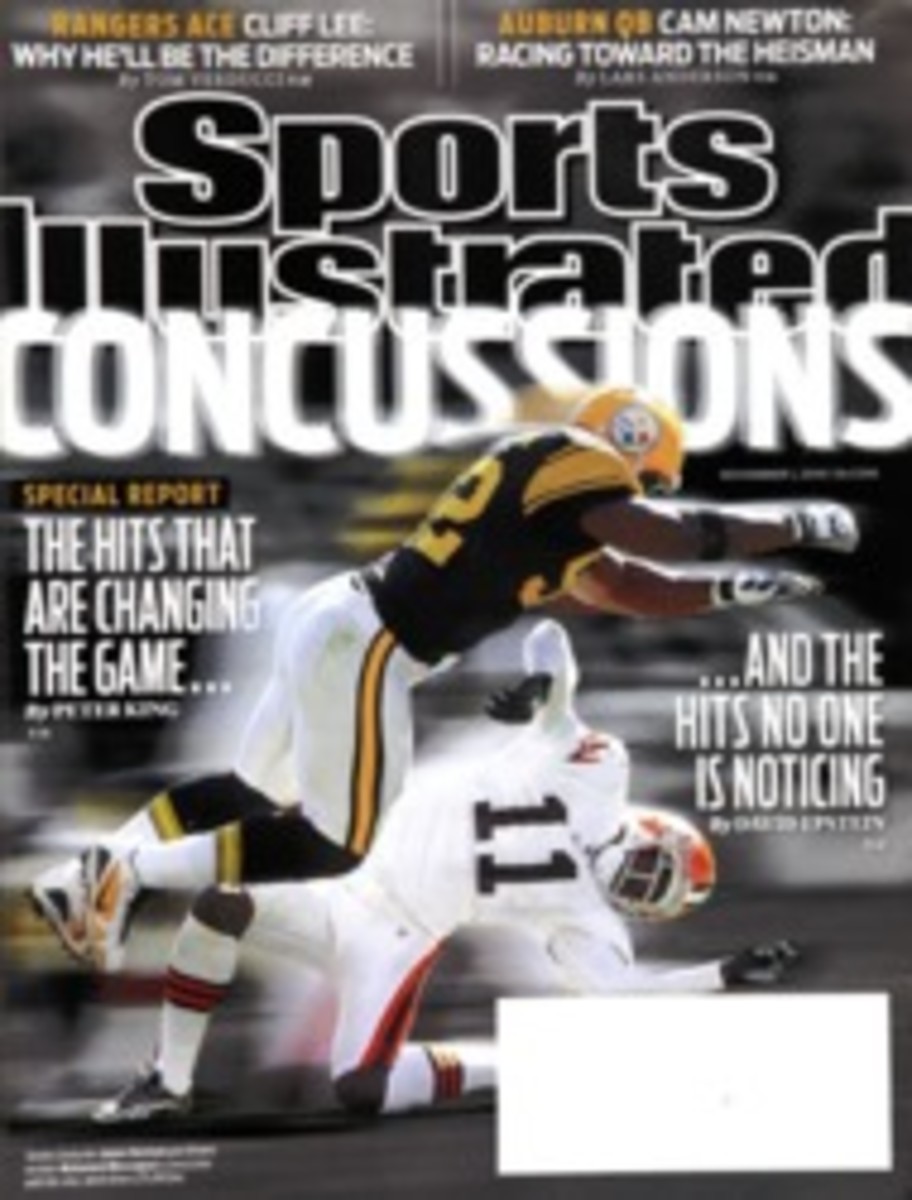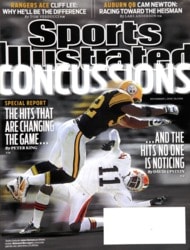
WHIPLASH EFFECT
HELMETS AREN'T perfect. They can be extremely effective at preventing skull fractures and helpful for absorbing the brain-rattling force of a blunt impact. But a concussion often is not a direct result of a blow to the head, but rather of the rapid front-to-back or side-to-side snap that can occur when the body or head is buffeted by a heavy force. Think of a car that is rear-ended: Even without being hit in the head, a whiplashed passenger can suffer a concussion. The brain, anchored in the back by the brain stem, moves at a different speed from the rest of the head and shifts like jelly in a swinging jar. In severe cases it can even bounce off the inside of the skull.
To entirely prevent concussive head-snapping, a helmet would have to be anchored to the body. That's precisely how the protective gear works in automotive sports such as NASCAR and monster truck rallies, which use the HANS (Head And Neck Support) Device. The device tethers the driver's helmet to a headrest connected to the shoulders so that the head does not snap forward in a crash.
In sports where the head has to move independently of the body, however, no HANS-ian solution is possible. The best things a football player can do to mitigate head-snapping are strengthen his neck muscles and be prepared. When a player braces for a blow, the tensing of the muscles in the neck can keep his head from jerking too fast—which is key, because the speed at which the head snaps and how long it takes to decelerate often determine whether a player is concussed. An example of fast deceleration took place in the Bears' Week 4 loss to the Giants. New York cornerback Aaron Ross got to quarterback Jay Cutler on a blitz, spun him around and dragged him to the ground. There was no helmet-to-helmet contact, though Cutler's head swung down and, when it slammed against the turf, decelerated almost instantly. Cutler missed the rest of that game and the game the following week with a concussion. If he had been able to tense his neck, the way a linebacker might brace to take on a fullback, Cutler might have avoided a concussion.
Neck tension and rapid head deceleration are critical elements in baseball and hockey, two sports that, like football, have become much more aware of concussions in recent years. Twins first baseman Justin Morneau suffered a concussion in July when he took a knee to the head trying to break up a double play. It was a seemingly innocuous play, but Morneau missed the remainder of the season. "There's not much cushioning when a knee hits a head," says Jeffrey T. Barth, director of the Brain Injury and Sports Concussion Institute at the University of Virginia School of Medicine, "and especially if [a player is] not expecting it, the head snaps on the neck."
The NHL has tried to eliminate blows that catch players by surprise, banning blindside hits last March. Last week the Mayo Clinic suggested that all hits to the head, blindside and otherwise, be banned from hockey, but the NHL's new rule is a good first step. The checks that a player doesn't see coming—and give him no time to tense his neck—are the most dangerous. The element of surprise may be why seemingly genteel equestrian sports have a high rate of concussions. "Riders fall off, or they're going down a trail and get hit in the head with a branch, or a horse stops at a jump and they're thrown off," Barth says. "[Concussions happen] also when they're grooming horses. The horse might move quickly and knock them against the wall in the stall." When an athlete is caught off guard, even a minor blow can be devastating.
PHOTO
HEINZ KLUETMEIER
BRACE YOURSELF Tensing their neck muscles might have helped Cutler (above) and Morneau (below) avoid the concussions they suffered on seemingly routine plays.
PHOTO
LOU CAPOZZOLA
[See caption above]
PHOTO
KATHY WILLENS/AP
[See caption above]
PHOTO
MIKE CASSESE/REUTERS (MORNEAU)
[See caption above]

